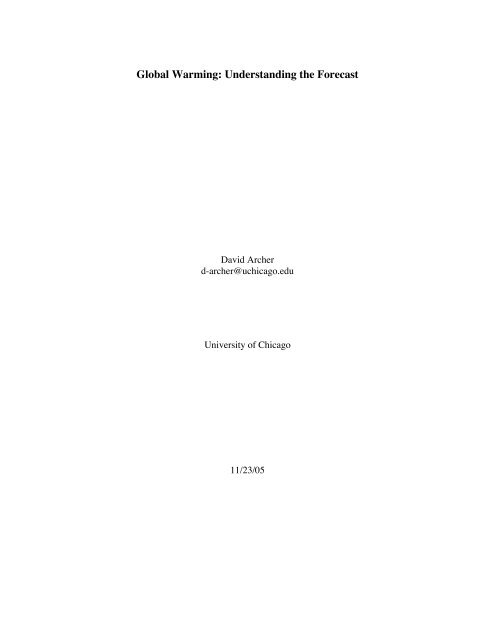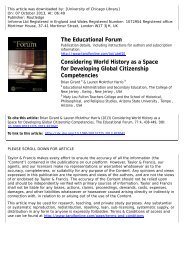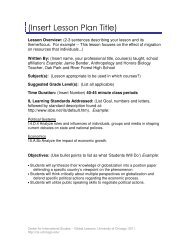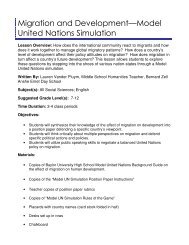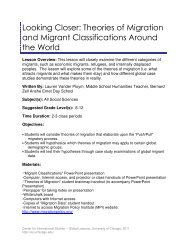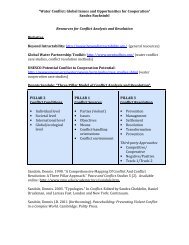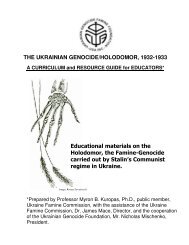David Archer - University of Chicago
David Archer - University of Chicago
David Archer - University of Chicago
Create successful ePaper yourself
Turn your PDF publications into a flip-book with our unique Google optimized e-Paper software.
Global Warming: Understanding the Forecast<br />
<strong>David</strong> <strong>Archer</strong><br />
d-archer@uchicago.edu<br />
<strong>University</strong> <strong>of</strong> <strong>Chicago</strong><br />
11/23/05
Table <strong>of</strong> Contents<br />
Preface<br />
Chapter 1 Humankind and Climate<br />
Section 1 The Greenhouse Effect<br />
Chapter 2 Blackbody Radiation<br />
Chapter 3 The Layer Model<br />
Chapter 4 Greenhouse Gases<br />
Chapter 5 Temperature Structure <strong>of</strong> the Atmosphere<br />
Chapter 6 Heat, Winds, and Currents<br />
Chapter 7 Feedbacks<br />
Section II The Carbon Cycle<br />
Chapter 8 Carbon on Earth<br />
Chapter 9 Fossil Fuels<br />
Chapter 10 The Perturbed Carbon Cycle<br />
Section III The Forecast<br />
Chapter 11 Is It Reliable<br />
Chapter 12 The Forecast<br />
Chapter 13 Decisions, Decisions<br />
Glossary
On-Line Models<br />
A model <strong>of</strong> infrared radiation in the atmosphere<br />
http://forecast.uchicago.edu/Projects/modtran.html<br />
A model <strong>of</strong> visible + infrared radiation in the atmosphere<br />
http://forecast.uchicago.edu/Projects/full_spectrum.html<br />
A model <strong>of</strong> the geological carbon cycle<br />
http://forecast.uchicago.edu/Projects/geocarb.html<br />
ISAM Integrated assessment model for future climate change<br />
http://forecast.uchicago.edu/Projects/isam.html<br />
A Hubbert's Peak calculator<br />
http://forecast.uchicago.edu/Projects/hubbert.html<br />
The Kaya Identity model for the growth <strong>of</strong> the human footprint<br />
http://forecast.uchicago.edu/Projects/kaya.html<br />
Browsing the results <strong>of</strong> a coupled climate model<br />
http://forecast.uchicago.edu/Projects/bala.html
Preface<br />
Global Warming: Understanding the Forecast is based on a class for undergraduate<br />
non-science majors at the <strong>University</strong> <strong>of</strong> <strong>Chicago</strong>, developed by Ray Pierrehumbert and<br />
myself. The class serves as partial fulfillment <strong>of</strong> our general education or “core” science<br />
requirements. We teach the class, and I have written the textbook, in a mechanistic way.<br />
We are aiming to achieve an intuitive understanding <strong>of</strong> the ropes and pulleys <strong>of</strong> the<br />
natural world, a fundamental scientific foundation that will serve the student for longer<br />
than would a straight presentation <strong>of</strong> the latest predictions.<br />
The text is aiming at a single problem, that <strong>of</strong> assessing the risk <strong>of</strong> anthropogenic<br />
climate change. The story ranges from science to economics to policy, through physics,<br />
chemistry, biology, geology, and <strong>of</strong> course atmospheric science. We see the distant past<br />
and the distant future. In my opinion, by looking at one problem from many angles the<br />
student gets a pretty decent view <strong>of</strong> how a working scientist really thinks. This is as<br />
opposed to, say, taking a survey tour <strong>of</strong> some scientific discipline.<br />
The text is suitable for students <strong>of</strong> all backgrounds. We do make some use <strong>of</strong> algebra,<br />
mostly in the form <strong>of</strong> what are known as (gasp) story problems. The student will be<br />
exposed to bits and pieces <strong>of</strong> chemistry, physics, biology, geology, atmospheric science,<br />
and economics, but no prior knowledge <strong>of</strong> any <strong>of</strong> these topics is required. One can learn<br />
something <strong>of</strong> what each field is about by learning what it is good for, within the context<br />
<strong>of</strong> the common unifying problem <strong>of</strong> global warming.<br />
I have provided a project associated with each chapter after the first, either a<br />
computer lab or a paper and pencil exercise, suitable to do in lab sections or as<br />
homework. The first three are paper and pencil, aimed at building a foundation for<br />
understanding the computer labs that follow. The models run on our computers at the<br />
<strong>University</strong> <strong>of</strong> <strong>Chicago</strong>, and you can access them through web pages. No special setup <strong>of</strong><br />
the student’s computer is required, and the students can work equally well in a computer<br />
lab or at Starbuck’s (actually, it would be interesting to see if that’s true.).<br />
This book benefited by thorough, thoughtful reviews by Andy Ridgwell, Stefan<br />
Rahmstorf, Gavin Schmidt, and a fourth anonymous reviewer. The web interface to the<br />
models benefited from input by Jeremy <strong>Archer</strong>. The visible/IR radiation model was<br />
constructed by Ray Pierrehumbert and Rodrigo Caballero. The ISAM carbon cycle<br />
model was provided by Atul Jain. The cover photo <strong>of</strong> the glacier was taken by Lonnie<br />
Thompson. The background photo was taken by Elizabeth Lockwood on South Manitou<br />
Island in Michigan. The Project in Chapters 11 and 12 makes use <strong>of</strong> model output<br />
provided by G. Bala, and is plotted using ferret, developed at NOAA PMEL.<br />
Dedicated to George Lockwood, and the spirit <strong>of</strong> curiosity.
Chapter 1. Humankind and Climate<br />
Everyone always complains about the weather, but no one<br />
ever does anything about it. Mark Twain.<br />
The Glaciers are Melting, But Is It Us<br />
Is it really possible that human activity could alter the weather As I write it is a<br />
crisp, clear fall day. What would be different about this day in 100 years, in a world<br />
where the chemistry <strong>of</strong> the atmosphere has been altered by human industrial activity<br />
There is no doubt that the earth is warming. Mountain glaciers are disappearing.<br />
The Arctic coast is melting. Global average temperature records are broken year after<br />
year. The growing season has been getting longer. Plans are being made to abandon<br />
whole tropical islands as they sink into the Pacific Ocean. Shippers are awaiting the<br />
opening <strong>of</strong> the Northwest Passage that early explorers searched for in vain, with the<br />
melting <strong>of</strong> sea ice in the Arctic. The Atlantic had so many hurricanes this season that<br />
they ran out <strong>of</strong> letters in the alphabet for names, and had to resort to Greek letters up to<br />
epsilon.<br />
Of course, the natural world is has variable weather all by itself, naturally. Is it likely<br />
that some <strong>of</strong> our recent weather has been impacted by human-induced climatge change,<br />
or how much <strong>of</strong> this would have happened anyway If humans are changing climate, do<br />
we know that this is a bad thing How does the future evolution <strong>of</strong> climate compare with<br />
the climate impacts we may be seeing today<br />
Weather versus Climate<br />
We should distinguish at the outset between climate and weather. Weather is chaotic,<br />
which means that it cannot be forecast very far into the future. Small errors in the<br />
forecast grow with time, until eventually the forecast is nothing but error. By "climate",<br />
we mean some sort <strong>of</strong> average <strong>of</strong> the weather, say averaged over 10 years, more or less.<br />
We cannot predict the details <strong>of</strong> rain versus shine on Tuesdays versus Saturdays very far<br />
into the future, but we can hope to forecast the average raininess <strong>of</strong> some location at<br />
some time <strong>of</strong> year. Weather is chaotic, but by taking the average, we arrive at something<br />
that is not chaotic, which seems to be in some ways predictable. We will return to this<br />
topic in Chapter 6.<br />
Human forcing <strong>of</strong> climate is expected to be small compared to the variability<br />
associated with the weather. Temperature in the coming century is projected to rise a by<br />
few degrees centigrade (Chapter 12). This is pretty small compared to the temperature<br />
differences between the equator and the pole, between winter and summer, or even<br />
between daytime and night. One issue this raises is that it is trickier to discern a change<br />
in the average, when the variability is so wild. Careers are spent computing a global<br />
average temperature from the 100+ year thermometer record (Chapter 11). The noise<br />
makes it more difficult to see a trend and know for sure what the trend is.<br />
Chapter 1 12/18/05 1
The small change in the average relative to the huge variability also raises the<br />
question <strong>of</strong> whether a change in the average will even be noticeable. One way that the<br />
average weather matters is in precipitation. Ground water tends to accumulate, reflecting<br />
rainfall over the past weeks and months and years. It may not matter to a farmer whether<br />
it rains on Tuesday versus Saturday, but if the average rainfall in a region changes, that<br />
could spell the difference between productive farming and not. A change in the average<br />
climate will change the growing season, the frequency <strong>of</strong> extreme hot events, the<br />
distribution <strong>of</strong> snow and ice, the optimum growth localities <strong>of</strong> plants and agriculture, and<br />
the intensity <strong>of</strong> storms.<br />
In addition to day-to-day weather, there are longer-lasting variations in climate. One<br />
past climate regime was the Little Ice Age, ~1650 – 1800, bringing variable weather, by<br />
some records 1°C colder on average, to Europe. Before that was the Medieval optimum,<br />
perhaps 0.5°C warmer over Europe, coincident with a prolonged drought in American<br />
southwest. We will discuss the causes <strong>of</strong> these climate changes in Chapter 11, but for<br />
now it is enough to observe that relatively small-sounding average-temperature shifts<br />
produced noticeable changes in human welfare and the evolution <strong>of</strong> history. The climate<br />
<strong>of</strong> the Last Glacial Maximum, 20,000 years ago, was so different from today that the<br />
difference would be obvious even from space, and yet the average temperature difference<br />
between then and today was only about 5-6°C (Chapter 8). Another implication <strong>of</strong> these<br />
natural climate shifts is that it makes it more difficult to figure out whether the presentday<br />
warming is natural or caused by rising greenhouse gas concentrations and other<br />
human impacts on climate.<br />
Forecasting Climate Change<br />
The fundamental process that determines the temperature <strong>of</strong> the earth is the balance<br />
between energy flowing to the earth from the sun, versus energy flowing away from the<br />
earth into space. Heat loss from Earth depends on Earth’s temperature, among other<br />
things (Chapter 2). A hotter Earth loses heat faster than a cooler one, all else being equal.<br />
The earth balances its energy budget by warming up or cooling down, finding the<br />
temperature at which the energy fluxes balance, with outflow equaling inflow. The<br />
feedback is analogous to a sink with water flowing in from a faucet. The faucet fills the<br />
sink at some constant rate, while outflow down the drain depends on the water level in<br />
the sink. The sink fills up until water drains out as fast as it comes in (Chapter 3).<br />
The increase in outgoing energy with increasing temperature <strong>of</strong> the earth results in a<br />
feedback, which stabilizes the temperature <strong>of</strong> the earth at which the energy fluxes in and<br />
out balance each other (Chapter 7). It is possible to change the average temperature <strong>of</strong><br />
the earth by altering the energy flow either coming in or going out. In our sink, one way<br />
to raise the water level is to turn up the faucet and wait a few minutes. The water will<br />
rise until it finds a new equilibrium water depth. We can also alter the water level by<br />
partly constricting the drain. Egg shells and orange peels work well for this purpose. If<br />
the drain is partially obstructed, the equilibrium water level will rise.<br />
The incoming energy to Earth might change if the sun changes its brightness. It is<br />
known that there is a small variation in the brightness <strong>of</strong> the sun correlated with the<br />
Chapter 1 12/18/05 2
number <strong>of</strong> sunspots. Sometimes sunspots disappear altogether, presumably changing the<br />
solar output. The Maunder minimum was such a period, 1650-1700 and coincided with<br />
the Little Ice Age.<br />
Some <strong>of</strong> the incoming sunlight is reflected back to space without ever being absorbed<br />
(Chapter 7). It we somehow make the earth brighter, more reflective, it will tend to cool.<br />
Clouds reflect light, and so does snow. Bare soil in the desert reflects more light than<br />
vegetation does. Smoke emitted from coal-burning power plants contains particles that<br />
can reflect light. So, changes in cloudiness, land cover, and smoke can change climate.<br />
The climate forcing agent at the heart <strong>of</strong> the global warming problem is the<br />
greenhouse effect from rising CO 2 concentration in the atmosphere. CO 2 , a greenhouse<br />
gas, makes it more difficult for energy leaving the earth to escape to space. Most <strong>of</strong> the<br />
gases in the atmosphere are not greenhouse gases, but are completely transparent to<br />
infrared light. The outgoing energy from the earth passes through them as if they were<br />
not there. Greenhouse gases have the ability <strong>of</strong> absorb and emit infrared light. The<br />
impact they have on climate depends on their concentration, because more gas will<br />
absorb more light (Chapter 4). The strength <strong>of</strong> the greenhouse effect also depends on the<br />
temperature structure <strong>of</strong> the atmosphere (Chapter 5).<br />
Water vapor is a tricky greenhouse gas, because the amount <strong>of</strong> water vapor in the<br />
atmosphere is determined by climate. Water tends to evaporate when the air is warm,<br />
and condense as rain or snow in cool air. Water vapor, it turns out, amplifies the<br />
warming effects from changes in other greenhouse gases. This water-vapor feedback<br />
doubles or even triples the temperature change we expect from rising atmospheric CO 2<br />
concentration. Clouds are very effective at absorbing and emitting infrared light, acting<br />
like completely impenetrable greenhouse gas. A change in cloudiness also affects the<br />
visible-light incoming energy flux, by reflecting it (Chapter 7).<br />
Human activity has the potential to alter climate in several ways. Rising CO 2<br />
concentration from combustion <strong>of</strong> fossil fuel is the largest and longest-lasting humancaused<br />
climate forcing agent, but there are other greenhouse gases, such as methane and<br />
other carbon molecules, nitrous oxide, and ozone, whose concentrations are also<br />
changing because <strong>of</strong> human activities. Particles from smoke stacks and internal<br />
combusion engines reflect incoming visible light, altering the heat balance. Particles in<br />
otherwise remote clean air may change the average size <strong>of</strong> cloud droplets, which has a<br />
huge but very uncertain impact on sunlight reflection (Chapter 10).<br />
Many <strong>of</strong> these climate drivers themselves respond to climate, leading to stabilizing or<br />
destabilizing feedbacks. There are several examples where the prehistoric climate record<br />
shows more variability in climate than models tend to predict, presumably because there<br />
exist positive feedbacks in the real world that are missing in the models. For example,<br />
climate cools, so forest changes to tundra, allowing more <strong>of</strong> the incoming sunlight to be<br />
reflected to space, cooling the climate even more. A naïve model with forests that do not<br />
respond to climate would underestimate the total amount <strong>of</strong> cooling. In the global<br />
warming forecast, the feedbacks are everything. The forecast would be much easier in a<br />
simpler world (Chapter 7).<br />
Chapter 1 12/18/05 3
The forecast for the coming century is also tricky because some parts <strong>of</strong> the climate<br />
system take a long time to change, such as melting an ice sheet or warming the deep<br />
ocean. Coming back to our sink analogy, not only do we have to estimate the eventual<br />
change in the water level in the sink, but we also need to predict how quickly it will rise.<br />
For the sink that is not so bad, but for climate it makes the prediction considerably harder<br />
(Chapter 12).<br />
Carbon, Energy, and Climate<br />
Climate change from fossil fuel combustion is arguably the most challenging<br />
environmental issue we face, because CO 2 emission is at the heart <strong>of</strong> how we produce<br />
energy, which is pretty much at the heart <strong>of</strong> our modern standard <strong>of</strong> living. The<br />
agricultural revolution, which supports a human population <strong>of</strong> 6 billion people and<br />
hopefully more, has at its heart the industrial production <strong>of</strong> fertilizers, a very energy<br />
intensive process. It's not so easy to stop emitting CO 2 , and countries and companies that<br />
emit lots <strong>of</strong> CO 2 have strong interest in continuing to do so (Chapter 9).<br />
The energy we extract from fossil fuels originated in the nuclear fires <strong>of</strong> the sun.<br />
Visible light carried the energy to earth, where it was converted by photosynthesis in<br />
plants into chemical energy in chemical bonds <strong>of</strong> carbon, hydrogen, oxygen and other<br />
elements. Plants have two motives for doing this, one to store energy and the other to<br />
build CO 2 molecules from the atmosphere into the biochemical machinery <strong>of</strong> life<br />
(Chapter 8).<br />
Most <strong>of</strong> the biological carbon we use for fossil fuels was photosynthesized millions <strong>of</strong><br />
years ago. Over geologic time, some <strong>of</strong> the biological carbon has been converted into the<br />
familiar fossil fuels oil, natural gas, and coal. Coal is the most abundant <strong>of</strong> these, while<br />
the types <strong>of</strong> oil and gas that are currently being extracted will be depleted in a few<br />
decades (Chapter 9). Stored carbon energy is used to do work, in plants, animals, and<br />
now in automobiles, by reacting the carbon with oxygen to produce CO 2 . In living things<br />
this process is called respiration, explaining why we need to breathe (to obtain oxygen<br />
and get rid <strong>of</strong> CO 2 ) and eat (to get biological carbon compounds) (Chapter 8).<br />
CO 2 is released into the atmosphere to join the beautiful cacophony that is the carbon<br />
cycle <strong>of</strong> the biosphere. Trees and soils take up and release carbon, as does the ocean.<br />
Cutting <strong>of</strong> tropical forests releases CO 2 the atmosphere, while forests in the high latitudes<br />
appear to be taking up atmospheric CO 2 . Most <strong>of</strong> the CO 2 we release to the atmosphere<br />
will eventually dissolve in the ocean, but this process takes several centuries. A small<br />
fraction, about 10%, <strong>of</strong> the CO 2 released will continue to alter climate for hundreds <strong>of</strong><br />
thousands <strong>of</strong> years into the future (Chapter 10).<br />
Assessing the Risk<br />
Is mankind creating a global warming trend We can try to answer this question by<br />
comparing the history <strong>of</strong> Earth's temperature with the history <strong>of</strong> the different reasons why<br />
temperature might have changed, what we call climate forcings. The sun is more intense<br />
at some times than others. Volcanoes occasionally blow dust into the stratosphere where<br />
Chapter 1 12/18/05 4
it reflects sunlight back to space. Greenhouse gases and smokestack aerosols are two<br />
anthropogenic climate forcings. The conclusions we will come to are, first, that it is<br />
getting warmer, and second, that it is easy to explain the warming as caused by increased<br />
greenhouse gas concentrations, but impossible to explain them as occurring naturally<br />
(Chapter 11).<br />
The forecast for the climate <strong>of</strong> the coming century is for a temperature increase <strong>of</strong> 2-<br />
5°C by the year 2100. The amount <strong>of</strong> warming depends on the intensity <strong>of</strong> feedbacks<br />
with water vapor and clouds, but also on the time-dependent evolution <strong>of</strong> the climate<br />
system as it changes from one state to another. The feedbacks affect the intensity but<br />
also the response time <strong>of</strong> climate to the new greenhouse gas concentrations. An increase<br />
in temperature <strong>of</strong> a few degrees does not sound catastrophic, and for some parts <strong>of</strong> the<br />
world it may not be. We can get an idea <strong>of</strong> the effect <strong>of</strong> such a temperature change by<br />
looking into the past, at natural climate shifts that occurred through the last thousand<br />
years, perhaps 0.5-1°C changes, or at the end <strong>of</strong> the glacial maximum, a warming <strong>of</strong><br />
about 6°C on global average. Temperature changes as small as the 0.5° medieval warm<br />
time in Europe were associated with prolonged drought in the American southwest, <strong>of</strong><br />
sufficient intensity to spell the end <strong>of</strong> the Mayan civilization (Chapter 12).<br />
When we ask questions about the impact <strong>of</strong> global warming on humanity, we begin to<br />
enter the realm <strong>of</strong> the social sciences, especially <strong>of</strong> economics. Using models,<br />
economists can forecast the future just as meteorologists or climatologists can. One<br />
approach is to compare the predicted costs <strong>of</strong> predicted climate change against the<br />
predicted costs <strong>of</strong> avoiding climate change. It is <strong>of</strong> course difficult to put a monetary<br />
value on the natural world, but for what it is worth the projections are that reducing CO 2<br />
emissions substantially might cost a few percent <strong>of</strong> global net economic production<br />
(GNP). That certainly would be a lot <strong>of</strong> money if you were looking at it piled in a heap,<br />
but in an economy that is growing by a few percent per year, a cost <strong>of</strong> a few percent per<br />
year would only set the trajectory <strong>of</strong> economic production back by a year or two (Chapter<br />
13).<br />
Economics is an awkward tool for use in global-warming decision making, however.<br />
For one thing, it seems crass to represent the demise <strong>of</strong> the natural world, biodiversity<br />
and wilderness, as a simple monetary cost. Economics is not well suited to comparing<br />
costs across long stretches <strong>of</strong> time, because <strong>of</strong> a concept called the discount rate. Finally,<br />
economic forecasts in general are trickier than the climate forecast, because the<br />
underlying laws <strong>of</strong> economics are not as simple and immutable as they are in the physical<br />
world. Ultimately, the question <strong>of</strong> climate change may be a matter <strong>of</strong> ethics and fairness,<br />
as much as one <strong>of</strong> pr<strong>of</strong>it and loss.<br />
Greenhouse gas emission to atmosphere is an example <strong>of</strong> a situation called the<br />
tragedy <strong>of</strong> the commons. The benefits <strong>of</strong> fossil fuel combustion go to the individual,<br />
while the costs <strong>of</strong> climate change are paid by everyone. In this situation there is a natural<br />
tendency for everyone to over-exploit the commons. The solution to this is some form <strong>of</strong><br />
collective regulation. International negotiations have resulted in an agreement called the<br />
Kyoto Protocol, which aims to limit emissions <strong>of</strong> CO 2 gas. The Kyoto Protocol, if<br />
Chapter 1 12/18/05 5
successful, would curtail emissions by about 6% below 1990 levels, while carbon cycle<br />
models show that eventual cuts <strong>of</strong> order 50% would be required to truly stabilize the CO 2<br />
concentration <strong>of</strong> the atmosphere.<br />
Carbon emissions could be lessened quite a bit by conservation and efficiency.<br />
Sources <strong>of</strong> carbon-free energy such as windmills and solar energy exist and are rapidly<br />
being scaled up. A forecast <strong>of</strong> the amount <strong>of</strong> energy civilization will require in the<br />
coming century suggests that large, new sources <strong>of</strong> energy may be required in the future.<br />
Nuclear energy is essentially carbon-free but it would take a new nuclear power plant <strong>of</strong><br />
current design built every other day for the next 100 years to keep up with forecast<br />
energy demand. New ideas include solar cells on the moon, beaming energy back to<br />
Earth as microwave radiation, or high-altitude windmills, mounted on kites tethered in<br />
the jet stream.<br />
With our growing technological and intellectual prowess, as well as our exploding<br />
population, we are slowly taking over the job <strong>of</strong> managing the biosphere. May we do it<br />
wisely!<br />
Chapter 1 12/18/05 6


